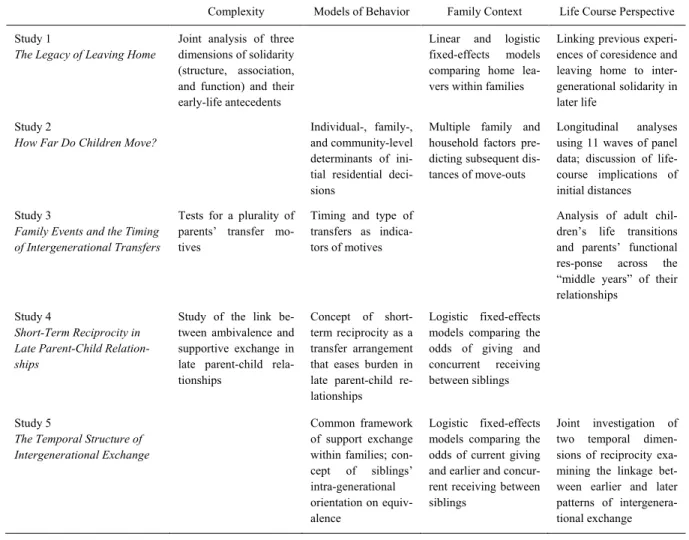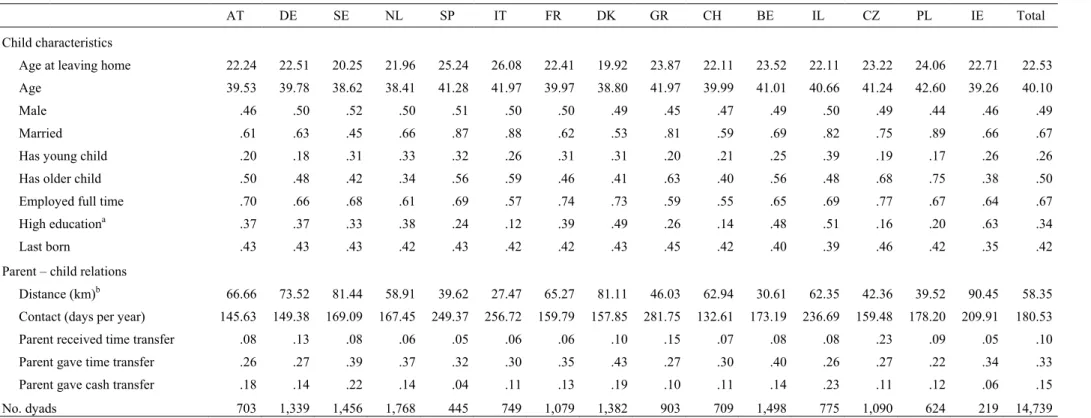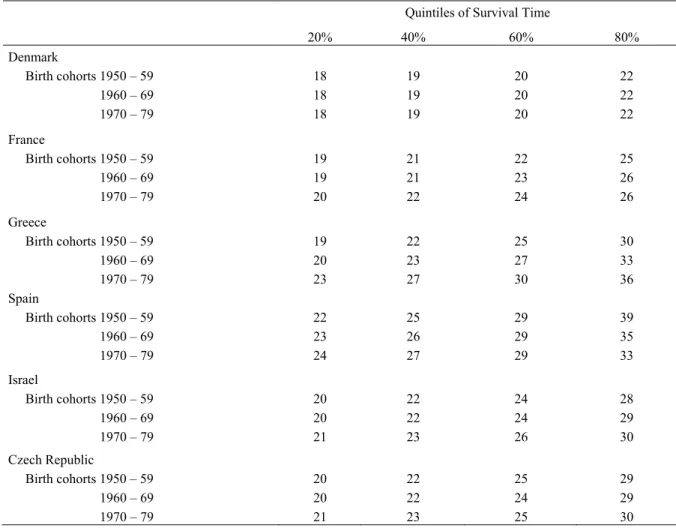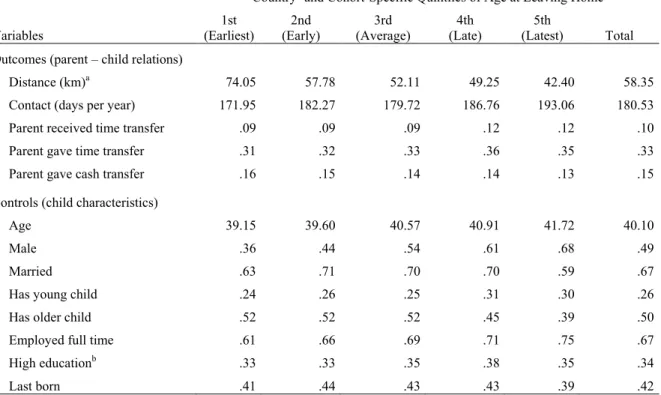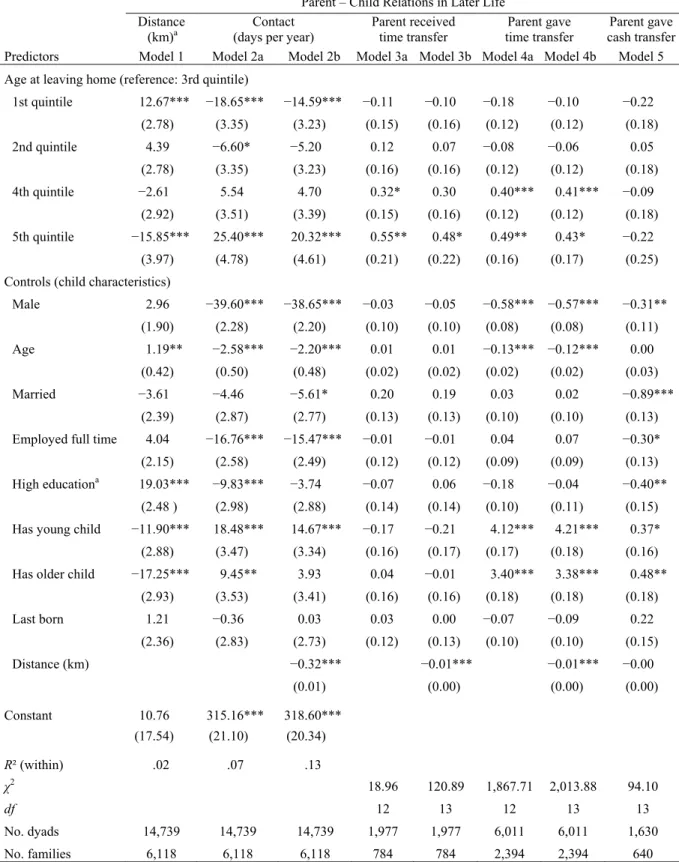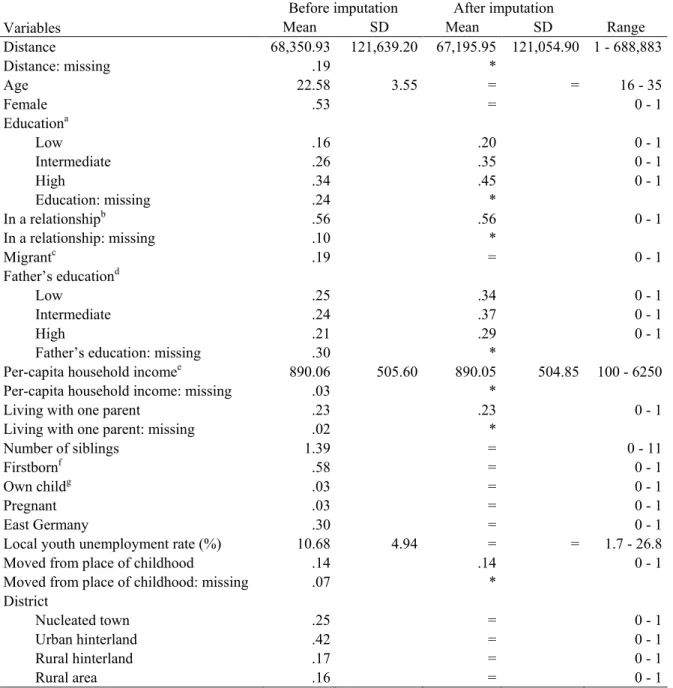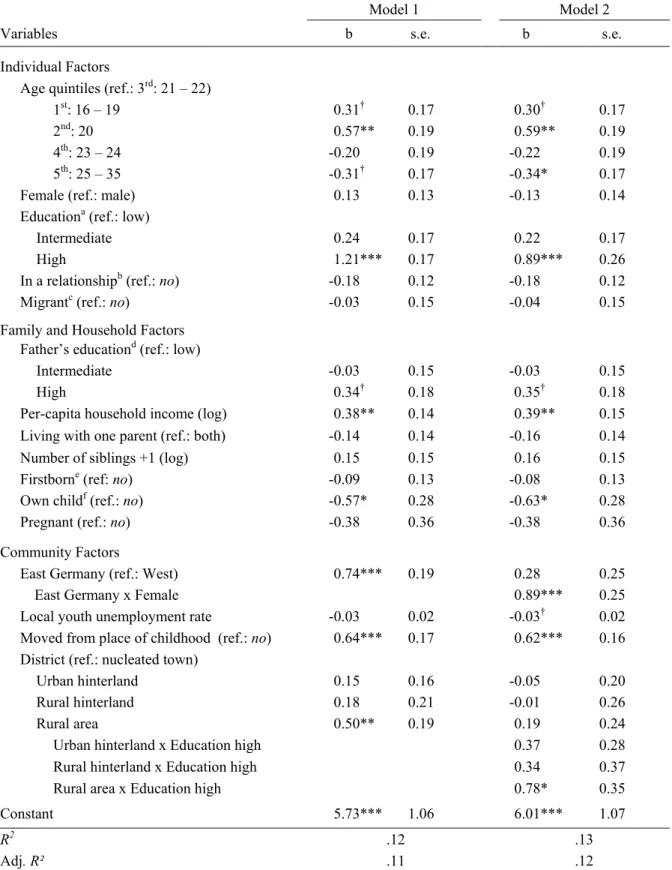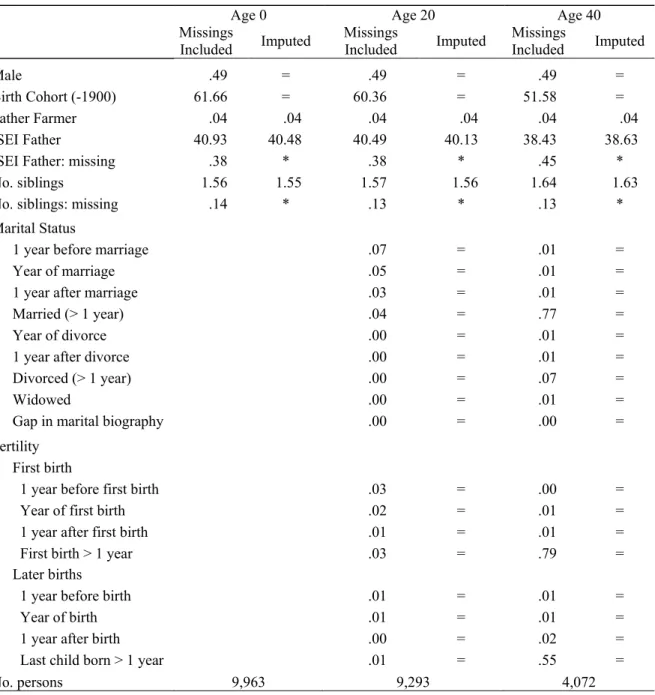Linked Lives
Within Families and Across Generations
Dissertation
zur Erlangung des akademischen Grades eines Doctor rerum politicarum an der Fakultät Sozial- und Wirtschaftswissenschaften
der Otto-Friedrich-Universität Bamberg
vorgelegt von Thomas Leopold
im April 2012
Datum der Disputation: 09. Juli 2012 Prüfungskommission
Prof. Dr. Henriette Engelhardt-Wölfler (Erstgutachterin) Prof. Dr. Thorsten Schneider (Zweitgutachter)
Prof. Dr. Hans-Peter Blossfeld
Publication record of the articles contained in this dissertation (as of July, 2012)
Study I
Leopold, Thomas (2012): “The Legacy of Leaving Home: Long-Term Effects of Coresidence on Parent-Child Relationships”, Journal of Marriage and Family 74(3): 399- 412.
Study II
Leopold, Thomas, Ferdinand Geissler, & Sebastian Pink (2012): “How Far Do Children Move? Spatial Distances After Leaving the Parental Home”, Social Science Research 41(4): 991-1002.
Study III
Leopold, Thomas, & Thorsten Schneider (2011): “Family Events and the Timing of Inter- generational Transfers”, Social Forces 90(2): 595-616.
Study IV
Leopold, Thomas, & Marcel Raab (2011): “Short-Term Reciprocity in Late Parent-Child Relationships”, Journal of Marriage and Family 73(1): 105-119.
Study V
Leopold, Thomas, & Marcel Raab: “The Temporal Structure of Intergenerational Exchange:
A Within-Family Analysis of Parent-Child Reciprocity”, revise & resubmit at Journal of
Gerontology: Social Sciences.
Contents
Introduction...……….……….……….…. 7
Study I
The Legacy of Leaving Home:
Long-Term Effects of Coresidence on Parent-Child Relationships.………... 39
Study II
How Far Do Children Move?
Spatial Distances After Leaving the Parental Home………... 63
Study III
Family Events and the Timing of Intergenerational Transfers……… 91
Study IV
Short-Term Reciprocity in Late Parent-Child Relationships……….. 119
Study V
The Temporal Structure of Intergenerational Exchange:
A Within-Family Analysis of Parent-Child Reciprocity………. 145
Danksagung……….… 167
Introduction
Dramatic improvements in life expectancy coupled with declines in fertility have profoundly changed the structure of families. The number of living generations has increased whereas the size of each generation has decreased. One of the most important implications of this transformation “from pyramids to beanpoles” (Bengtson, 2001) are longer years of shared lives between the generations. Today’s duration of intergenerational relationships is unprec- edented in human history. Most people can expect to spend three or more decades of their adult years with living parents. As a result, there is a remarkable increase in the availability of intergenerational kin as family resources and an extended period for supportive exchanges across the life course (Putney & Bengtson, 2003).
In sharp contrast to previous concerns about the weakening of intergenerational bonds in modern societies (e.g., Parsons, 1943), more recent scholarship has emphasized their stability and continued importance as a source of social integration and mutual assistance.
Indeed, some analysts argue that intergenerational relationships may be more important today than ever before, representing a latent support network (Riley & Riley, 1993) that is activated in times of need and particularly adaptive to the uncertainties of contemporary life courses. As Swartz (2009, p. 193) notes, “[w]ith longer lives and fewer in the younger generation to share with, the older generation has more attention, time, and resources to give to each child and grandchild. Likewise, younger generations—with fewer children to care for and fewer active childrearing years—may have more time and resources to help aging parents.” The vital importance of intergenerational relationships for ageing societies has also been recognized by policymakers. Recently, the European Commission (2005) highlighted solidarity between the generations as one of the crucial dimensions for Europe’s development.
Thus, it is not surprising that scientific interest in intergenerational relationships, in particular those between parents and adult children, has grown rapidly in recent decades.
Hundreds of studies examined the nature of these ties, seeking to identify patterns of contact,
shared activities, geographical proximity, emotional closeness, normative obligations, and functional support exchange. A number of consistent findings emerged from this literature.
In Western economies, intergenerational relationships are largely portrayed as close, harmonious, and supportive. More than half of adult children, for instance, live within one hour of travel time from their parents, speak to them at least once a week, and report high levels of affection (see Swartz, 2009, for a review). With regard to functional assistance, parents remain “net givers” across many years. This functional support consists of various forms and is typically measured as flows of money and time (instrumental help, personal care, looking after grandchildren, etc.). The cascade pattern from the older to the younger generations is particularly strong where financial transfers are concerned, but it also holds for time transfers, albeit less pronounced. In fact, the balance of support exchange favors adult children until the onset of parents’ health decline at ages over 70 or even 80 (Albertini et al., 2007; Rossi & Rossi, 1990). Subsequently, however, previously “overbenefited” adult children represent one of the most reliable sources of support for elderly parents. This is especially true for daughters who are more forthcoming in responding to parental need than sons, in particular with regard to caregiving (Spitze & Logan, 1990). Taken together, the empirical evidence paints a picture of “lifelong solidarity” (Szydlik, 2000) between the generations and highlights the continued importance of extended family ties for social integration and individual well-being.
These findings constitute an important baseline by which to assess the characteristics of
intergenerational relationships and their current potential to serve parents’ and children’s
needs. Yet they provide only limited information about how families will respond to
changing conditions. It is clear that past and present demographic shifts will significantly
alter the context for intergenerational relationships in future decades and pose new
challenges to ageing societies. Extant research, however, is mainly based on older cohorts of
parents that differ markedly from the baby boomers who are currently approaching the
threshold of old age (Suitor et al., 2011). In their decade review of research on ageing and
family life, Silverstein and Giarrusso (2010, p. 1039) emphasized that “relationships (…)
have become more fluid and less predictable, as reduced fertility and increased rates of
divorce, remarriage, and stepfamily formation have altered the microcontext in which
intergenerational, spousal, and sibling relationships function.”
Future cohorts of elderly parents will reach all-time record levels of longevity. These cohorts will be of greater size, in better health, and more diverse in their kinship structures.
Their children will have experienced greater difficulty in attaining a stable financial position and benefited extensively from substantial amounts of parental assistance received across their adult years. Given the risks of contemporary life courses such as high levels of marital instability and labor market uncertainty in early careers (Blossfeld et al., 2005; 2011), parents as family safeguards represent a critical source of support for adult children, ensuring stability and assisting them both in building their lives and in recuperating from adverse events such as job loss or divorce.
On the other hand, adult children will more often face caregiving decisions in later life, in which case there will be fewer siblings to share the responsibility (Bengtson, 2001). Thus, a growing need for upstream assistance, albeit tempered and postponed by increases in parents’ healthy life expectancy, will coincide with a shortage of potential providers. In the United States, the proportion of solitary caregivers increased by 50 percent already through the 1990s, indicating a weaker safety net for frail parents and greater burden on children who respond to their need (Wolff & Kasper, 2006). Moreover, an increasing number of daughters are part of the labor force, incurring greater opportunity costs of providing intergenerational assistance and possibly altering ideas of which child is supposed to shoulder the load.
Indeed, some analysts have expressed concern about a decline in filial commitment to parental care (Silverstein & Giarrusso, 2010). Public policy, however, relies on the middle,
“sandwiched” generation who must balance investments in careers and families of their own against responsibilities toward their ageing parents (Schneider et al., 2001; Schoeni & Ross, 2005).
These current and projected trends are changing the face of families and will possibly
lead to shifts in the supportive behavior between the generations. This raises a variety of new
questions about the nature and dynamics of intergenerational linkages, in particular with
regard to the provision of instrumental assistance. How do family support systems adapt to
future demographic, social, and economic conditions in ageing societies? More specifically,
how do parents support their offspring’s passage to independence and protect them against
the risks of contemporary life courses? Conversely, can future cohorts of elderly parents rely
on their children to provide help and care in later life?
Four Principles of Research on Intergenerational Relationships
What kind of research is needed to address these questions? Obviously, an empirical assess- ment of current intergenerational relationships and their covariates is not sufficient. There- fore, recent research has called for greater attention to four main issues: the complex nature of intergenerational ties, models of behavior in parent-child relationships, the family context in which they are embedded, and an expanded life course perspective which covers the mid- dle years of intergenerational relationships and links earlier experiences to family outcomes in later life.
First, research on intergenerational relationships in ageing societies requires conceptual and empirical models that capture their complexity. The complex nature of these ties is reflected in the influential model of “intergenerational solidarity” (Bengtson and Schrader, 1982) which distinguished between six analytical components of cohesion and integration across generations. Starting with a seminal article on “intergenerational ambivalence”
(Lüscher & Pillemer, 1998), further attention has been devoted to the complexity of later parent-child relationships in which solidarity and conflict coexist. This perspective highlights the importance of ambivalent feelings in both generations deriving from mixed emotions and contradictory role expectations. Ambivalence, rather than solidarity, is assumed to represent the fundamental feature characterizing intergenerational relationships (Pillemer & Suitor, 2008a). Although this line of research is developing rapidly, little is known to date about how ambivalence is related to family outcomes such as transfers of time and money.
Second, the study of intergenerational relationships calls for theoretical models of
individual behavior. Such models are essential to understanding how family members
respond to changing conditions (Becker, 1991). This point has long been recognized in the
field of economics where the interest is mainly in how individuals’ choices maximize their
utility gained from family transactions. The economic study of intergenerational ties largely
focuses on motives behind intergenerational transfers testing two models of behavior,
altruism and exchange. Despite a large number of empirical studies, economic research on
transfer motives did not yield conclusive evidence in support of one model. From a
sociological vantage point, concentrating on a single motive represents an overly simplistic
approach ignoring the actual plurality and variability of motives that are continuously
negotiated in the family context and shaped by cultural factors and social norms. In this respect, Bianchi and associates (2008, p. 17) stressed that “despite the multiplicity of motives, identifying when and why a particular model is operating is important for understanding intergenerational behavior.”
Third, research on intergenerational relationships should reach beyond the dyadic view, considering other relationships within the family. In most studies, parent-child relationships are studied in isolation from the larger family context in which they are embedded. This focus on explaining between-family differences fails to account for the obvious variation of parent-child relationships within families: Parents, for example, frequently name favorite children (Suitor et al., 2008) and differentiate among them when providing or asking for assistance (Pillemer & Suitor, 2006). Furthermore, dyadic processes are profoundly influenced by other relationships in the family. Systemic approaches to studying parental care, for example, consider the surrounding network structure of siblings as alternative providers. In recent years, within-family designs have been increasingly recognized as a powerful tool for understanding intergenerational ties (e.g., Davey et al., 2009)
Fourth, since the 1990s there is a growing number of studies investigating
intergenerational relationships from a life course perspective. This perspective highlights
two increasingly important aspects in the study of intergenerational relationships: First,
intergenerational relationships unfold across many years of development and the impact of
experiences from earlier life may resurface even decades later. Second, the notion of “linked
lives” (Elder et al., 2003) draws attention to the ways in which each generation’s life events
such as marriage, the birth of a child, divorce, or health decline affect family members of
other generations. Neither of these two aspects, however, is well-understood in the current
literature. The main reason for this is an “alpha-omega tendency” (Hagestad, 1987) of
research focusing either on earlier or on later parent-child relationships (Bucx, 2009). Thus,
only few studies (e.g., Parrott & Bengtson, 1999; Silverstein et al., 2002) have attempted to
establish a link between these periods. We know relatively little, for example, about the
long-term effects of support received in earlier life on children’s later propensity to assist
their elderly parents (Swartz, 2009). A further consequence of the alpha-omega tendency is
that research has largely ignored the “middle years” of parent-child relationships (Bucx,
2009). As a result, the study of linked lives did not consider the intergenerational effects of
many important transitions, particularly those experienced by adult children who establish their lives after leaving the parental home.
T
HEORETICALB
ACKGROUND ANDP
REVIOUSR
ESEARCHThese four principles constitute the basic conceptual framework of this dissertation. The following sections outline this framework in more detail, discussing previous research on each of the four principles.
The Complexity of Intergenerational Relationships: Solidarity and Ambivalence
Over the past three decades, the model of intergenerational solidarity (Bengtson & Schrader, 1982) has been the principal framework in the study of parent-child relationships. This mod- el has guided much of the empirical analysis of intergenerational relationships and was in- corporated into several research programs (Suitor et al., 2011). According to Bengtson (2001), the term solidarity “characterize[s] the behavioral and emotional dimensions of in- teraction, cohesion, sentiment, and support between parents and children, grandparents and grandchildren, over the course of long-term relationships” (p. 8). Bengtson and his col- leagues formulated the solidarity model on the basis of data from the Longitudinal Study of Generations, an ongoing panel study of white Americans in which family members from different generations were repeatedly interviewed across several years. The model posits that intergenerational family solidarity consists of six interconnected dimensions: associational solidarity is indicated by the frequency of contact and shared activities; affectual solidarity by feelings of emotional closeness; consensual solidarity by perceived similarity and agree- ment on values, attitudes, and beliefs; functional solidarity by the exchange of instrumental transfers; normative solidarity by the degree of commitment to family roles and the strength of filial obligations; and structural solidarity by the opportunities for intergenerational inter- action such as the presence of family members, their health, and geographical proximity (Bengtson & Roberts, 1991).
This comprehensive typology of feelings, values and attitudes, behavior, and structural
opportunities for interaction has proven valuable for analyzing the nature, quality, and
intensity of intergenerational ties. Suitor and associates (2011) distinguish between three
directions of research guided by the solidarity model. First, studying a single component, for
instance functional support, as a predictor of parent and child outcomes such as health, well- being, and educational attainment; second, conceptualizing family solidarity as an outcome jointly measured by two or more of its components; third, investigating the interdependence of different components of solidarity. Particularly research from the second and third of these directions has demonstrated the benefits of the solidarity model for capturing the complexity of intergenerational relationships.
One notable application of this basic framework was the identification of five types of relations between adult children and their mothers and fathers in American families (Silverstein et al., 1997): tight-knit (high levels on all six dimensions), sociable (high levels of affection, proximity, and association – low levels of support), intimate but distant (high levels of affection and consensus – low levels of proximity, association, and support), obligatory (high levels of proximity and contact – low levels of affection and consensus), and detached (low levels on all six dimensions). Importantly, the authors found a very heterogeneous pattern in the distribution of these types of parent-child relationships. No dominant type emerged from the analysis and overall, the “variegated forms” were more prevalent than tight-knit and detached relationships. The latter types correspond to the notions of the traditional or corporate extended family (tight-knit) and the isolated extended family (detached). In contrast, the sociable, obligatory, and intimate but distant relationships are broadly consistent with concepts of the modified extended family (Litwak, 1960) and the
“latent matrix of kin connections” (Riley & Riley, 1993) that lies dormant before being activated in times of need.
Despite its evident merits, the solidarity model was repeatedly criticized for an alleged
bias in favor of positive characteristics of intergenerational relationships. For example,
negative aspects such as tension, conflict, abuse, and caregiver stress could at best be
inferred from the absence of solidarity. Furthermore, the solidarity model did not consider
the complexity resulting from contradictory family roles and opposing feelings that may
coexist in parent-child relationships. Against this background, Lüscher and Pillemer (1998)
proposed intergenerational ambivalence “as a ‘general orientation’ to the subject of
intergenerational relationships” (p. 414).
This concept posits that ambivalence, rather than solidarity, is the fundamental feature characterizing the ties between parents and adult children. The authors define intergenerational ambivalence as follows:
“[T]he term (…) designate[s] contradictions in relationships between parents and adult offspring that cannot be reconciled. The concept has two dimensions: (a) contradictions at the level of social structure, evidenced in institutional resources and requirements, such as statuses, roles, and norms and (b) contradictions at the subjective level, in terms of cognitions, emotions, and motivations” (Lüscher & Pillemer, 1998, p. 416).
One example for ambivalence concerns the sustained provision of assistance to elderly par- ents. Adult children as caregivers adhere to norms of filial responsibility and experience pos- itive feelings of loyalty towards their frail parents. At the same time, they are distressed by the imbalance of continuous giving, violating the norm of reciprocity. Parents at the receiv- ing end also experience ambivalence as they benefit from their offspring’s solidarity while feeling guilty about overburdening them and being unable to reciprocate (George, 1986).
By highlighting the presence of contradictory norms, roles, and feelings in family interactions, the ambivalence perspective contributes to understanding further aspects of complexity in parent-child relationships that research framed by the solidarity model had largely ignored. Still, it is a relatively recent addition that awaits further study, in particular with regard to the link between ambivalence and the decisions made to accommodate or relieve these feelings. Bengtson and colleagues (2002, p. 574), for example, called for research to demonstrate the utility of the concept by answering questions such as: “How does ambivalence predict the likelihood of providing support to an elderly parent?”
Recently, the solidarity model has been expanded to incorporate intergenerational conflict and ambivalent relationships (Silverstein et al., 2010). Overall, solidarity and ambivalence can now be regarded complementary rather than competing perspectives in the study of intergenerational relationships (Bengtson et al., 2002; Silverstein & Giarrusso, 2010).
Models of Behavior in Parent-Child Relationships: The Study of Transfer Motives
Above and beyond these conceptual frameworks, research in the field of economics and,
more recently, also in sociology, has concentrated on individual motives of behavior in par-
ent-child relationships. These studies focus mainly on the provision of intergenerational
transfers as a behavioral manifestation of individual motives held by parents and adult child- ren. Economists are particularly interested in modeling the situation in which an individual decides to transfer his or her resources to family members. This decision is assumed to be governed by individual transfer motives that lead to a certain evaluation of a situation and a specific behavioral response that maximizes the giver’s utility. Importantly, these models allow predicting how actors will respond to changing conditions (e.g., pension cuts, increa- sed taxation of private transfers, etc.) – under the condition that the motive for giving private transfers is known.
Economic research typically seeks to infer this motive from survey data on individual transfer behavior. This line of inquiry is generally predicated on the existence of a singular, well-defined motive (Kohli & Künemund, 2003). The literature is divided into two clear camps, one advancing altruism, the other exchange. As a result, these transfer motives are commonly viewed as competing and tested against each other. Such tests typically focus on how intergenerational transfers are distributed and divided with regard to the givers’ and recipients’ economic situation. In the altruistic model (Becker, 1974), givers are concerned about the receivers’ well-being. Therefore, the receiver’s utility is integrated into the giver’s utility function. An important implication is that transfers will only occur in the presence of need (Becker, 1981). Altruistic parents, for example, always consider their children’s current and anticipated needs, directing their resources to those who experience the greatest economic need and thus benefit most from the transfer. Consequently, altruistic models predict a negative relationship between children’s economic means and their chances to receive parental transfers. Likewise, altruistic children are expected to provide care only if their older parents are in poor health.
In contrast to altruism, economic models of exchange assume that intergenerational transfers reflect self-interested behavior. Transfers are only given with the expectation of some return. Kotlikoff and Morris (1989), for instance, proposed that money transfers from parents to children represent a “bribe” buying their social support. Conversely, the anticipation of a future reward may be an incentive to support frail but well-off parents; that is, children initiate the exchange and parents balance the support accounts later. One prominent example is the model of “strategic bequests” (Bernheim et al., 1985), in which
“parents threaten to disinherit miscreant offspring, or more subtle, (…) reward more
attentive children with family heirlooms” (p. 1046). A large number of studies tested the models of altruism and exchange against each other and numerous findings were presented in support of each motive (e.g., Cox, 1987; Wilhelm, 1996; McGarry & Schoeni, 1997).
Overall, the empirical evidence remains inconclusive.
Sociological research on transfer motives differs from economic research in two important respects (Kohli & Künemund, 2003). First, it rejects the notion that each individual holds only one well-defined motive. Instead, this perspective considers the interplay of multiple motives that may be held simultaneously, compete or overlap, and change across the life course. The underlying idea is that the observable heterogeneity of transfer behavior reflects an actual plurality and variability of motives. Second, sociological research recognizes that intergenerational transfers can hardly be considered “pure”
economic acts. Transfers within the family domain are assumed to be constrained by family norms and to entail additional qualities beyond individual utility functions which may affect intergenerational bonds. As Kohli and Künemund (2003) note,
“it makes a difference whether transfers from (…) family members are motivated by self-interest (only) or (also) by love, benevolence, generosity, or a sense of personal obligation. For example, a gift of money has a different quality if given unconditionally,
‘without strings attached,’ or if given conditional on compliance with expectations of exchange, reciprocity, control, or status.” (p. 126)
The motives discussed in the sociological literature belong to three broad categories that are assumed to jointly influence transfer behavior: affection, norms of responsibility, and norms of reciprocity (Doty, 1986).
The first category shares some affinity with the altruistic model as transfers are given
without the expectation of any compensation. In contrast to the altruistic motive, however,
the occurrence of these transfers is not predicated on the recipients’ need. Transfers
motivated by intergenerational affection are simply seen as an unconditional expression of
love and benevolence given both in the presence and in the absence of need. The second
category, norms of responsibility, refers to the generalized expectation that parents and
children should support each other. These norms oblige family members to provide
intergenerational assistance regardless of emotional closeness and without the expectation of
compensation (Stein et al., 1998; Gans & Silverstein, 2006). Similar to the altruistic model,
transfer behavior that is governed by norms of responsibility depends on the recipient’s need; that is, obligations to assist family members apply only to situations in which support is required.
Third, a sociological equivalent to the economic exchange motive is the norm of reciprocity. The analysis of reciprocity derives from Mauss’s (1994[1923/24]) seminal essay on “The Gift”. Mauss distinguished between three basic obligations that create and maintain bonds between members of primitive societies: giving, accepting the gift, and giving back.
Recipients who accept a gift remain indebted to the giver until an equivalent return-gift restores the balance. Reciprocity as a universal norm, an idea later advanced by Gouldner (1960, p. 170), “defines certain actions and obligations as repayments for the benefits received.” This notion of reciprocity has been applied to the longitudinal study of support exchange in parent-child relationships. Because of their intimate and lasting character, parent-child relationships were assumed to be balanced only over extended time spans covering several years or even decades between parents’ earlier investments and children’s later repayments (Hollstein & Bria, 1998). In contrast to the economic exchange motive, adherence to the norm of reciprocity, rather than self-interested behavior, is assumed to govern the exchange. This point is illustrated, for example, by the model of a “support bank”
(Antonucci & Jackson, 1990). Parents who support their children do not expect future repayments but “buy in” to a generalized system of reciprocity. They draw on these deposits only in times of need – as adult children feel obliged to reciprocate the benefits received.
In sum, the perspectives described above, although not exhaustive, show that different disciplines have proposed a variety of conceptual frameworks and theoretical insights regarding intergenerational transfer behavior. Each singular model is limited in scope and none provides a general answer to the question of what motivates parents and children who transfer their resources to the other generation. Recent reviews, however, did not interpret this as an unfortunate lack of consensus reflecting a vague, ambiguous, and inconclusive state of research. Rather, the diversity of models was praised for reflecting the actual complexity of intergenerational relationships. For instance, Bianchi and colleagues (2008, p.
5) emphasize that “[n]one of these ideas is likely to explain all behaviors, but rather, we
expect that they all play a role in comprising the complicated relationships observed among
family members.” In a similar vein, Silverstein and Giarrusso (2010, p. 1052) concluded
“that it is potentially healthier for the field to let many middle-level theories bloom than have a single perspective dominate in a hegemonic fashion.”
The Context of Intergenerational Relationships: A Within-Family Perspective
Except for the few families in which only one parent and one child are alive, intergenera- tional relationships are embedded in a larger family context. The fact that two members of a dyad are influenced by relationships with third actors has long been recognized in sociology (Simmel, 1964) and social psychology (Heider, 1958). Nonetheless, extant research on inter- generational relationships does often not sufficiently account for the family as a small group structure surrounding dyadic interactions between parents and children.
For example, one widely used analytical strategy is to study a child’s relationship to a parent in isolation from other family ties (e.g., Hogan et al., 1993; Silverstein et al., 1997).
Other analysts use aggregated measures such as “distance to the closest living child” (e.g., Hank, 2007). Still others regard the fact that many families comprise multiple dyads between parents and children primarily as a statistical problem. These studies address the non- independence of observations in datasets containing more than one dyad from the same family by calculating robust standard errors or estimating multilevel models (e.g., Brandt et al., 2009). Although such approaches are appropriate to address a variety of research questions, they suffer from confounding dyadic and family characteristics. Analytically, a specific dyad from one family is compared to a dyad with different characteristics from a different family (Hofferth, 2005). Therefore, dyadic approaches implicitly assume that a parent’s relationship with one child is independent of that parent’s relationships with any other child (Pillemer & Suitor, 2008b). As a result, these designs are clearly limited in understanding various important intergenerational phenomena such as the distribution of transfers across children and the negotiation of parental care among siblings.
In contrast, within-family designs allow assessing the importance of individual or dyadic
characteristics relative to those of other individuals and dyads in a family. This approach has
two main analytical benefits for understanding intergenerational ties. First, it controls for all
background characteristics that are constant within a family. In family fixed-effects models,
these factors drop out of the estimation and are thus rendered inconsequential. Importantly,
these models do not require that shared family factors are actually observed. All
characteristics, both observed and unobserved, are controlled – based on the assumption that they are common to all units within a family. This property of fixed-effects models is particularly valuable for family studies because many possible confounders are family-level factors that are very difficult to measure using standardized survey questions. Family norms arising from the interaction of its members, for example, are often unmeasured (Bianchi et al., 2008). Thus, one might for instance incorrectly infer parent-child reciprocity from the observation of support exchanged in both directions because shared family norms to unconditionally support each other are not controlled.
The second benefit of within-family designs is that they are often superior in modeling the substantive outcome of interest. One prominent example is parental care. Including all adult children into the unit of analysis enables the analyst to understand how the supportive link between an elderly parent and a particular child is affected by other children as alternative or complementary providers. This allows examining a specific caregiving arrangement as an outcome of the negotiation of responsibilities among siblings and as a team effort requiring coordination between different providers (Finch & Mason, 1993). As Silverstein and Giarrusso (2010, pp. 1051f) have noted, this approach is “most informative because they come closest to representing caregiving as it is actually experienced in families.”
Within-family designs require large samples, however. Comparisons between parents or between siblings necessitate that at least two of them are present. In addition, the empirical analysis of binary family outcomes (e.g., provision of care: yes or no) draws on a conditional likelihood approach that drops all families without variation in the dependent variable from the estimation (Chamberlain, 1980).
A Comprehensive Life Course Perspective on Intergenerational Relationships
The life course perspective, widely considered the main theoretical advance in family rese-
arch of the 1990s (Allen et al., 2000), is today one of the most common orientations in the
study of intergenerational relationships. Its overarching principles draw attention to indivi-
dual development and change over time, the historical and social contexts in which lives
unfold, the timing of transitions into new positions and roles, the importance of individual
agency, and the joint dynamics of interdependent lives (Elder et al., 2003). The life course
perspective highlights two aspects that are particularly relevant for understanding intergen- erational ties, namely the notion of “linked lives” between parents and children and the later- life consequences of previous experiences in their relationships (Bucx, 2009).
First, the principle of “linked lives” pertains to the fact that intergenerational bonds are among the closest and most enduring of all social relationships. Consequently, parents’ and children’s life courses are intimately intertwined and profoundly affected by events experienced by the other generation. There are numerous examples for such linkages:
children’s transition to parenthood implies parents’ transition to grandparenthood; the last child’s move-out empties the nest, ending the parenting years; parents’ divorce entails detrimental effects on the quality of relations to children; health declines initiate intergenerational caregiving; and so on. In Elder’s (1985, p. 40) words, “[e]ach generation is bound to fateful decisions and events in the other’s life course.” The analytical implication is that individual decisions should not be studied in isolation from the context constituted by family members’ interrelated lives. Instead, a focus on interdependent decisions is well- suited to account for the multiple connections by which changes in parents’ lives may affect their children, and vice versa.
Second, the life course perspective provides a lens through which to view how previous experiences are carried over into later family life. This focus on long-term effects is particularly relevant for research on intergenerational relationships, as they often stretch over several decades. Obviously, understanding late parent-child relationships requires consideration of their rich history covering numerous life transitions and related experiences.
Studies that focus only on current needs, for instance, miss the processes by which earlier
levels of affection, geographical proximity, frequency of interaction, and functional support
may have set the stage for supportive ties observed in later life. This concerns, for example,
the idea of long-term reciprocity described above. Although it is generally recognized that
family relations build on previous experiences, only a modest number of empirical
investigations exist (e.g., Rossi & Rossi, 1990; Parrott & Bengtson, 1999; Silverstein et al.,
2002). This is partly due to the scarcity of data covering family relationships over extended
periods. A second reason is an “alpha-omega tendency” (Hagestad, 1987) of parent-child
research which often focuses only on early relationships, the “parenting years”, or on late
relationships, the “ageing years” (Bucx, 2009).
This tendency is related to another major shortcoming of research on intergenerational relationships: Little is known about how these ties develop across the “middle years” of parents’ and children’s shared lifetime. The middle years begin with young adults’ departure from the parental home and end when elderly parents become increasingly frail and dependent. Bucx (2009) describes this period as follows:
[T]he ‘middle years’ can be characterized as a phase in which both generations are relatively free from clearly circumscribed responsibilities to provide care to each other (…) [and,] as children move into adult roles, this is also the period in which children and parents begin to establish adult-to-adult relations with each other.” (p. 28)
A better understanding of these middle years is fundamentally necessary: First, with the
dramatic gains in healthy life expectancy, this period has greatly expanded over the past dec-
ades and it is likely to continue expanding in the future. Today, parents and adult children in
Western economies can expect this period to last 20 or even 30 years and longer. Thus, with
regard to the total duration of cosurvivorship, the middle years currently account for roughly
half of parents’ and children’s shared lifetime. Second, several key transitions typically fall
into this period, including parents’ retirement and grandparenthood as well as children’s
marriage, labor market entry, parenthood, and divorce. Importantly, with the increasing un-
certainty of contemporary life courses (Blossfeld et al., 2011), parents’ assistance in building
and rebuilding lives is often indispensable to children who experience these transitions
(Ploeg et al., 2004). Third, in keeping with the principle outlined above, this downward as-
sistance may be an important factor conditioning late parent-child relationships. Thus, con-
sidering intergenerational life course linkages across the middle years contributes to under-
standing adult children’s transfers of help and care in later life.
O
VERVIEW OF THEF
IVES
TUDIESThe following overview offers a brief look at the five studies contained in this dissertation.
Each summary explains a study’s theoretical background, analytical approach, and main results, discussing its contribution to research on intergenerational relationships and the sociology of families.
Study I: “The Legacy of Leaving Home: Long-Term Effects of Coresidence on Parent-Child Relationships”
Coresidence between parents and adult children is a ubiquitous phenomenon in Western economies. Children often benefit from their parental home as a home base and “feathered nest” until advanced ages. In fact, the majority of 22-year-olds in Europe still live with their parents. In Southern countries, the median age at home leaving is even above 25. Further- more, in many industrialized countries such as the United States, the decline of intergenera- tional coresidence has reversed since the 1990s and the prevalence of this living arrangement increases (Fleck, 2009; Ruggles, 2007). In view of that, it is not surprising that numerous studies have investigated extended coresidence between the generations and the timing of leaving the parental home.
In contrast, almost nothing is known about the consequences of this transition although several analysts have speculated about possible long-term effects of extended coresidence on parent-child relationships. Swartz (2009, p. 201), for example, noted that the experience of living with parents “may change the way young adults think of and relate to their families once they establish financial independence” and stressed the importance of “understand[ing]
better how extended support in young adulthood affects long-term intergenerational relations and exchange with parents later in life.” In a similar vein, Mitchell (2006) discussed long- term reciprocity as a mechanism by which the time spent in the parental home may set the stage for late parent-child relationships:
“Notably, young adult coresiders may want to provide more help to parents in later life (…) than non-coresiders in an attempt to “repay” parents for providing them with a home base and burdening them with extra household responsibilities in their time of need (…). In this way, extended coresidence has the potential to enhance
intergenerational solidarity and facilitate the continuation of supportive relations across the life courses of parents and their children” (p. 88).
